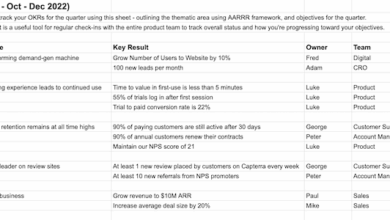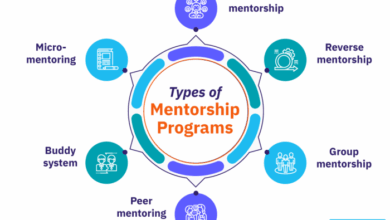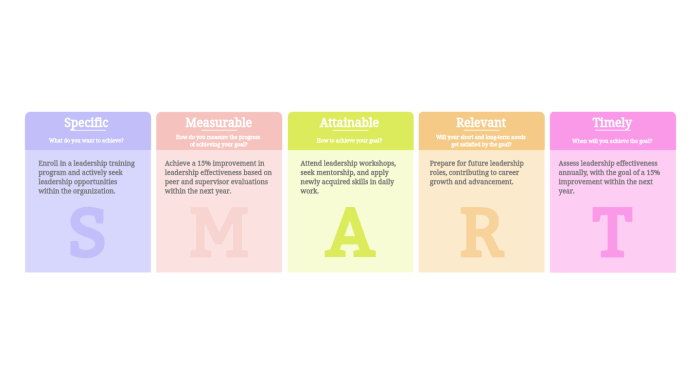
Leadership smart goals examples provide a structured approach to achieving ambitious objectives. This guide explores the creation, implementation, and evaluation of effective smart goals tailored for various leadership roles, from team leaders to CEOs. We’ll delve into defining smart goals, setting them for different levels of leadership, and the strategies for successful execution, including adapting to change. Understanding the potential obstacles and methods for overcoming them is also crucial for successful leadership.
The key is to tailor goals to individual leadership styles and challenges, while maintaining clarity and measurable outcomes. We’ll provide real-world examples and case studies to illustrate how leadership smart goals can drive positive organizational change across diverse industries. This comprehensive guide offers a roadmap for creating, monitoring, and refining leadership smart goals for optimal results.
Defining Smart Goals: Leadership Smart Goals Examples
Setting SMART goals is crucial for effective leadership. It provides a structured framework for defining objectives, measuring progress, and ensuring accountability. Leaders who employ SMART goals are better equipped to achieve desired outcomes and inspire their teams towards common success. This framework empowers leaders to navigate challenges and capitalize on opportunities more effectively.SMART goals are not just a theoretical concept; they are a practical tool that translates vision into tangible results.
By incorporating specific, measurable, achievable, relevant, and time-bound characteristics, leaders can transform vague aspirations into actionable plans. This clarity empowers both the leader and the team to focus efforts and resources efficiently.
Examples of SMART Goals in Leadership Contexts
Effective leadership goals should align with the overall organizational strategy. These goals are not isolated but rather integral components of a larger vision. Here are some examples:
- A team leader aiming to improve team morale might set a goal to “Increase team engagement by 15% within the next quarter by implementing weekly team-building activities and regular feedback sessions.”
- A project manager seeking to enhance project efficiency might aim to “Reduce project completion time by 10% by implementing a standardized project workflow and utilizing project management software.”
- A CEO focused on increasing profitability might set a goal to “Increase annual revenue by 12% within the next fiscal year by launching new product lines and improving customer retention strategies.”
Characteristics of a SMART Goal, Emphasizing Leadership Application
SMART goals possess five key characteristics that make them effective for leadership. Understanding these characteristics is essential for crafting goals that drive positive change and inspire action.
- Specific: Goals should be clearly defined, leaving no room for ambiguity. For instance, instead of “Improve team performance,” a specific goal would be “Increase team productivity by 10% in the next quarter through the implementation of new workflow processes.” This clarity ensures everyone is on the same page.
- Measurable: Goals must be quantifiable. This allows for tracking progress and assessing success. A measurable goal for a project manager would be “Reduce project delays by 15% by implementing a project tracking system.” This metric allows for monitoring progress against the goal.
- Achievable: Goals should be realistic and attainable given available resources and constraints. An achievable goal for a team leader might be “Increase team collaboration by 20% within the next quarter by introducing collaborative tools and encouraging cross-functional communication.” It should be attainable with the team’s current skillset and resources.
- Relevant: Goals should align with the overall organizational strategy and individual roles. A relevant goal for a project manager would be “Improve project quality by 5% by implementing rigorous testing and quality control procedures,” contributing to the larger goal of high-quality project deliverables.
- Time-Bound: Goals should have a specific timeframe for completion. A time-bound goal for a team leader would be “Increase team member satisfaction scores by 10% within the next quarter by implementing regular one-on-one meetings and providing opportunities for skill development.” This sets a deadline for achieving the goal.
Types of Leadership Goals and Their SMART Goal Structures
Different leadership roles require different types of goals. Understanding these nuances allows for the creation of more effective and targeted goals.
- Team Leadership Goals: Focus on team performance, morale, and productivity. SMART goals might aim to “Increase team morale by 15% within the next quarter by introducing a new recognition program and providing additional training opportunities.”
- Project Management Goals: Center on project completion, cost, and quality. A SMART goal for a project manager could be “Complete the project within budget and on time by 10% by implementing a project tracking system and utilizing a dedicated project management software.”
- CEO Goals: Oriented towards organizational growth, profitability, and market position. A SMART goal for a CEO could be “Increase market share by 5% within the next fiscal year by launching a new product line and expanding into a new market.”
Comparing and Contrasting SMART Goal Examples for Different Leadership Roles
| Leadership Role | SMART Goal Example | Specific | Measurable | Achievable | Relevant | Time-Bound |
|---|---|---|---|---|---|---|
| Team Leader | Increase team morale by 15% within the next quarter by introducing a new recognition program and providing additional training opportunities. | Yes | Yes | Yes | Yes | Yes |
| Project Manager | Complete the project within budget and on time by 10% by implementing a project tracking system and utilizing a dedicated project management software. | Yes | Yes | Yes | Yes | Yes |
| CEO | Increase market share by 5% within the next fiscal year by launching a new product line and expanding into a new market. | Yes | Yes | Yes | Yes | Yes |
Setting Goals for Different Leadership Levels
Leadership is about setting a clear vision and inspiring others to achieve it. Effective leaders understand that goals should be tailored to the specific responsibilities and challenges faced by different levels of leadership. This understanding ensures that everyone is working towards a shared objective while acknowledging their unique roles and impact.Different leadership roles demand varying degrees of strategic thinking, operational efficiency, and team management.
Consequently, the SMART goal criteria must adapt to these distinctions to remain relevant and impactful. This adaptability fosters a more comprehensive and effective approach to achieving organizational objectives.
Setting smart goals for leadership is crucial, especially in today’s rapidly changing world. For instance, a smart goal might be to increase employee engagement by 15% within the next quarter. However, the recent news about nitro hackers rifle through chemical companies secret data highlights the importance of robust cybersecurity measures. This underscores the need for leaders to consider the potential risks and proactively create smart goals that safeguard sensitive information, ensuring the safety and well-being of the organization.
SMART Goal Criteria for Different Leadership Levels
Different leadership levels have distinct responsibilities and challenges. A team leader needs to focus on daily operations and team motivation, while a department head needs to balance departmental objectives with overall organizational strategies. Executives, on the other hand, need to align the entire organization with its mission and vision. Consequently, SMART goals should be adjusted to reflect these differing needs.
Tailoring SMART Goals to Leadership Challenges
To effectively tailor SMART goals, leaders need to understand the specific challenges and opportunities in their roles. A team leader, for instance, might face challenges in team morale or workflow efficiency. A department head may need to address inter-departmental conflicts or resource allocation. Executives might need to focus on market trends, regulatory changes, or technological advancements.Understanding the specific challenges allows leaders to formulate SMART goals that are more effective in addressing these challenges.
For example, a team leader aiming to improve team morale might set a goal to implement a weekly team-building activity. A department head striving to enhance inter-departmental collaboration might set a goal to organize joint projects. An executive aiming to improve market share might set a goal to introduce a new product line.
Comparing and Contrasting Team Leader vs. CEO Goals
A team leader’s goals are typically focused on improving team performance and fostering a positive work environment. A CEO, on the other hand, must consider the long-term strategic direction of the entire organization.
- Team Leader Goals: A team leader might set a SMART goal to increase team productivity by 15% within the next quarter by implementing a new project management system. This goal is Specific (increase productivity), Measurable (15%), Achievable (with a new system), Relevant (to team performance), and Time-bound (next quarter).
- CEO Goals: A CEO might set a SMART goal to increase market share by 10% within the next fiscal year by introducing a new product line targeting a specific demographic. This goal is Specific (increase market share), Measurable (10%), Achievable (with a new product), Relevant (to the company’s strategic direction), and Time-bound (next fiscal year).
Table of Leadership Goals and SMART Goal Structures
This table Artikels the differences in leadership goals and their associated SMART goal structures.
| Leadership Level | Focus Area | Example SMART Goal |
|---|---|---|
| Team Leader | Team performance, motivation, workflow | Increase team productivity by 10% by implementing a new project management system within the next quarter. |
| Department Head | Departmental performance, inter-departmental collaboration, resource allocation | Enhance cross-departmental communication by 20% through monthly team meetings and a new communication platform within the next six months. |
| Executive | Organizational strategy, market position, financial performance | Increase market share by 5% within the next fiscal year by launching a new product line targeted at a specific demographic. |
Strategies for Achieving Leadership Smart Goals
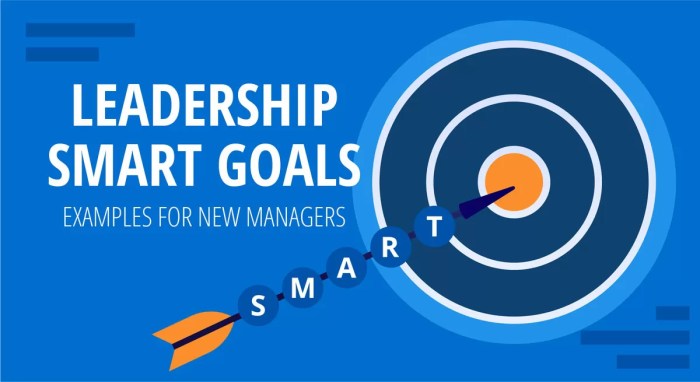
Turning ambitious leadership goals into tangible achievements requires a strategic approach. This involves more than just defining the goals; it necessitates a robust plan for monitoring progress, adapting to change, and leveraging feedback effectively. Successful leadership hinges on the ability to refine and execute strategies as circumstances evolve. This section delves into the practical methods for achieving leadership smart goals.Effective leadership smart goals are not static documents.
They are dynamic frameworks that need to be adjusted and refined based on feedback, changing conditions, and performance data. The strategies discussed below will guide you through the process of not only achieving your goals but also ensuring that your team remains focused and engaged throughout the journey.
Monitoring Progress Toward Leadership Smart Goals
Monitoring progress is crucial for staying on track and identifying potential roadblocks. Regular assessments allow for timely adjustments to strategies and ensure alignment with the initial objectives. This includes using key performance indicators (KPIs) and tracking metrics that directly relate to the goals.
- Regular check-ins with the team are vital for assessing progress. These meetings should be focused on addressing challenges, celebrating successes, and recalibrating the strategy when necessary.
- Implementing a system for tracking progress allows for a more detailed analysis of individual and team performance. This data-driven approach can identify trends and patterns, facilitating more effective decision-making.
- Establish clear milestones and deadlines for each phase of the goal. These markers will serve as checkpoints for assessing progress and making course corrections as needed.
The Role of Feedback in Achieving Leadership Smart Goals
Feedback is a cornerstone of improvement. It provides insights into the effectiveness of strategies and helps identify areas where adjustments are necessary. Constructive feedback, when implemented correctly, can lead to substantial progress.
Setting smart goals for leadership is crucial, but in today’s world, a silent majority might not be enough. The shift towards more vocal and visible participation, as explored in the article about the death of the silent majority , means leaders need to adapt their approaches to engagement. Examples of smart goals include fostering open communication and actively soliciting feedback, crucial for effective leadership in this evolving environment.
- Actively solicit feedback from team members, stakeholders, and mentors. Their perspectives can offer valuable insights that might otherwise be overlooked.
- Establish a culture of open communication and encourage feedback at all levels of the organization. This allows for a more thorough understanding of the challenges and opportunities.
- Use feedback to adapt strategies and improve the implementation process. This iterative approach ensures that the chosen strategies are aligned with the current context and most effective for achieving the goals.
Adapting Leadership Smart Goals in Response to Changing Circumstances
The business environment is constantly evolving. Leadership smart goals must adapt to these changes to remain relevant and effective. Proactive adjustments can mitigate potential setbacks and maintain momentum.
- Regularly review the goals in light of current market trends and emerging opportunities. Staying abreast of these changes will allow for proactive adaptation and responsiveness.
- Assess the impact of external factors on the goals. Economic downturns, technological advancements, and competitive pressures can all influence the effectiveness of leadership smart goals. A thorough analysis is key to adapting the strategy accordingly.
- Engage in scenario planning to prepare for potential disruptions. By exploring various possible futures, leaders can develop contingency plans to ensure that the goals remain achievable, even if external conditions change.
A Step-by-Step Procedure for Developing and Implementing Leadership Smart Goals
A systematic approach is crucial for successfully developing and implementing leadership smart goals. A well-defined procedure ensures that goals are aligned with organizational strategy and that resources are effectively allocated.
- Define clear and measurable objectives. Goals must be specific, measurable, achievable, relevant, and time-bound (SMART).
- Develop a detailed action plan outlining the steps required to achieve the goals. This includes assigning responsibilities, setting timelines, and identifying required resources.
- Implement the plan, monitoring progress regularly. This includes tracking key metrics and soliciting feedback to ensure alignment with the goals.
- Review and adjust the plan based on feedback and performance data. This iterative process is critical for adapting to changing circumstances and maintaining momentum.
Examples of Leadership Smart Goals in Action
Smart goals, when applied effectively by leaders, can drive significant positive change within organizations. They provide a structured framework for achieving ambitious objectives while maintaining focus and accountability. This section delves into practical applications of leadership smart goals across diverse industries, demonstrating their power to address specific organizational challenges.
Leadership Smart Goals in Technology
Technology companies often face rapid advancements and intense competition. Smart goals can be crucial for navigating these dynamics. For example, a tech company aiming to enhance its customer support might set a goal to reduce average response times by 20% within six months. This specific, measurable, achievable, relevant, and time-bound (SMART) goal allows the team to focus on training, process improvements, and technology upgrades, ultimately leading to improved customer satisfaction and retention.
Another example might involve increasing market share for a new product line by 15% within a year. This goal would necessitate strategies for marketing, sales, and product development, driving a more robust market presence.
Leadership Smart Goals in Healthcare
In healthcare, efficient resource allocation and patient care optimization are paramount. Smart goals can help hospitals and clinics streamline processes and improve patient outcomes. A goal to reduce patient wait times in emergency rooms by 10% within three months is an example of a measurable, achievable, relevant, and time-bound goal. This might require restructuring workflows, hiring additional staff, or implementing new technologies for scheduling and triage.
Similarly, improving patient satisfaction scores by 15% within a year could involve enhancing communication strategies, providing more accessible resources, and addressing patient feedback promptly.
Leadership Smart Goals in Education
Educational institutions often strive to enhance student learning outcomes and improve the overall educational experience. Smart goals in this sector can guide initiatives to bolster student engagement and teacher effectiveness. For example, increasing student participation in extracurricular activities by 15% over the next academic year is a SMART goal that can be achieved by promoting these activities through workshops and marketing efforts.
Another example involves improving teacher retention rates by 5% within the next year, potentially achievable through better compensation, improved professional development opportunities, and a supportive school culture.
Real-World Examples of Leadership Smart Goals
| Industry | Organizational Challenge | Leadership Smart Goal | Outcome |
|---|---|---|---|
| Retail | Increasing online sales | Increase online sales by 15% within the next quarter by implementing a new e-commerce platform and offering exclusive online promotions. | Successful implementation of a new e-commerce platform led to a 20% increase in online sales. |
| Finance | Improving customer satisfaction | Improve customer satisfaction scores by 10% within six months by actively soliciting feedback and implementing a new customer service training program. | Improved customer satisfaction scores by 12% and decreased customer complaints by 15%. |
| Manufacturing | Reducing production costs | Reduce production costs by 5% within one year by implementing lean manufacturing principles and upgrading existing machinery. | Successful implementation of lean manufacturing practices resulted in a 7% reduction in production costs. |
Case Studies of Successful Leadership Smart Goals
One notable example is a software company that aimed to increase customer retention. By implementing a customer feedback system and a targeted retention program, the company successfully increased customer retention by 15% within six months, leading to higher revenue and profitability. Another successful case study involves a healthcare organization that set a goal to reduce hospital-acquired infections by 10% within a year.
By implementing rigorous infection control protocols and enhancing staff training, the organization achieved a significant reduction in infections, positively impacting patient safety and reducing healthcare costs. These examples demonstrate the tangible impact that leadership smart goals can have across diverse industries.
Obstacles to Achieving Leadership Smart Goals
Leadership smart goals, while meticulously crafted, often face unforeseen challenges. These obstacles, if not anticipated and addressed proactively, can derail the best-laid plans and hinder progress toward organizational objectives. Understanding these potential roadblocks and developing strategies to overcome them is crucial for effective leadership.Successfully navigating these obstacles requires a deep understanding of the organizational context, the individuals involved, and the external factors impacting the goal’s achievement.
This understanding allows leaders to anticipate potential issues and develop contingency plans.
Potential Obstacles, Leadership smart goals examples
Effective leadership requires a keen awareness of the potential roadblocks that can impede progress. These obstacles can stem from internal or external factors, and understanding their nature is crucial to developing strategies for mitigation. Some potential obstacles include:
- Resource constraints: Limited budgets, insufficient personnel, or inadequate access to necessary tools and technology can significantly hinder progress toward smart goals. For instance, a team aiming to implement a new customer relationship management (CRM) system may face delays if the budget allocated is insufficient to cover the software licensing and training costs.
- Resistance to change: Employees may resist adopting new procedures, processes, or technologies, particularly if they perceive the changes as threatening or unnecessary. This resistance can stem from fear of the unknown, lack of understanding, or a perceived loss of control.
- Lack of commitment from stakeholders: Without buy-in from key stakeholders, a smart goal may struggle to gain momentum and support. This lack of commitment can stem from differing priorities, unclear communication, or a lack of trust in the leadership team.
- Unexpected external factors: Unforeseen market shifts, economic downturns, or unforeseen competitor actions can disrupt progress toward smart goals. For example, a company aiming to increase market share in a specific product category may see its efforts thwarted by a sudden rise in interest rates or a major competitor introducing a disruptive new product.
Strategies for Overcoming Obstacles
Developing proactive strategies to address potential obstacles is critical for success. Addressing these challenges head-on can help to minimize their impact and maintain momentum toward the desired outcome.
- Proactive communication: Open and transparent communication is vital in fostering understanding and buy-in from all stakeholders. Leaders should actively solicit feedback and address concerns promptly. This involves clear and consistent messaging throughout the organization to ensure everyone is aligned with the goals.
- Building consensus: Leaders should foster a collaborative environment that encourages participation and input from all levels of the organization. This can involve team-building activities, brainstorming sessions, and regular feedback mechanisms to ensure alignment and buy-in from stakeholders.
- Resource allocation: Efficient allocation of resources is essential to ensure that sufficient funding, personnel, and tools are available to support the achievement of the smart goals. Prioritization and effective budgeting are crucial in ensuring that resources are deployed optimally.
- Adaptability and flexibility: Leaders must be prepared to adapt their strategies and plans as needed in response to unexpected changes in the environment. Flexibility and a willingness to adjust course are critical in the face of unforeseen challenges.
Effective Communication’s Role
Effective communication is fundamental to mitigating obstacles and ensuring successful goal achievement. It fosters transparency, builds trust, and facilitates collaboration. Regular communication channels and feedback mechanisms are essential.
- Clarity and Transparency: Clear communication ensures that everyone understands the goals, expectations, and timelines. This transparency fosters trust and reduces ambiguity, which can be a significant obstacle.
- Active Listening: Leaders must actively listen to concerns and suggestions from team members and stakeholders. This demonstrates respect and fosters a sense of ownership.
- Two-Way Communication: Encourage feedback loops and open dialogues to ensure that concerns are addressed promptly and constructively.
Leadership Styles and Goal Achievement
Different leadership styles can have varying impacts on goal achievement. Understanding the nuances of various approaches allows leaders to adapt their style to best navigate obstacles and foster a productive environment.
- Transformational Leadership: This style emphasizes inspiration, intellectual stimulation, and individualized consideration. It can be particularly effective in overcoming resistance to change by motivating employees to embrace new initiatives.
- Servant Leadership: This approach prioritizes the needs of followers and fosters a supportive environment where individuals feel valued and empowered. This style can be highly effective in building consensus and addressing resistance to change.
Measuring and Evaluating Leadership Smart Goals
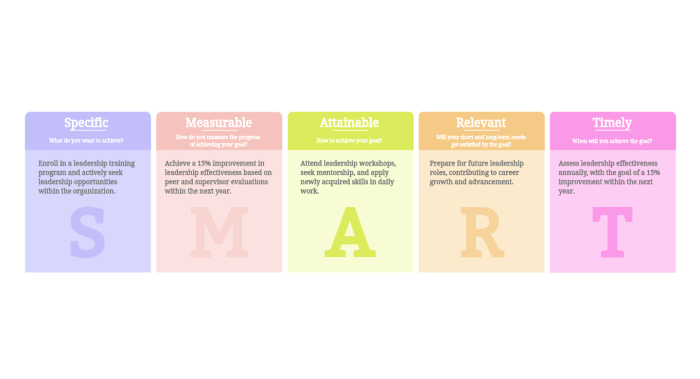
Defining and setting leadership smart goals is a crucial step in achieving organizational objectives. However, simply establishing goals isn’t enough; measuring progress and evaluating success is equally important. This process allows for adjustments and refinements, ensuring goals remain relevant and impactful. Effective evaluation mechanisms provide insights into the effectiveness of strategies and identify areas needing improvement.A comprehensive approach to evaluating leadership smart goals involves a blend of qualitative and quantitative methods.
This ensures a holistic understanding of the impact and progress towards the defined objectives. The use of metrics allows for tracking progress, identifying trends, and making data-driven decisions to optimize outcomes.
Methods for Evaluating Success
Understanding the effectiveness of leadership smart goals requires a multifaceted approach. Qualitative methods provide context and understanding of the impact of goals on people and processes, while quantitative methods offer concrete data points to track progress. Combining these approaches offers a richer understanding of the impact and success of the initiatives.
Setting smart goals for leadership is crucial, and examples often involve quantifiable targets. For instance, boosting team morale is a great aim, but making it SMART requires specifics like increasing positive feedback by 15% within the next quarter. This ties in nicely with how socialeyes lets Facebook friends chat Hollywood Squares style , fostering interaction and potentially boosting engagement.
Ultimately, effective leadership goals should be measurable and actionable, and these strategies can inspire and enhance collaboration within your team.
Metrics for Measuring Progress and Outcomes
A crucial aspect of evaluating leadership smart goals is the selection of appropriate metrics. These metrics should directly reflect the key aspects of the goal and be measurable. The chosen metrics should provide clear indicators of progress and outcomes, allowing for objective evaluation.
- Key Performance Indicators (KPIs): KPIs provide quantifiable measures of performance. Examples include increased sales, improved customer satisfaction scores, or reduced operational costs. They serve as tangible evidence of progress towards the goal.
- Qualitative Feedback: Gathering feedback from stakeholders, such as employees, customers, or partners, is valuable. This feedback can provide insights into the impact of the leadership smart goals on different perspectives and can identify potential areas for improvement. This might include surveys, focus groups, or one-on-one interviews.
- Project Milestones: Dividing a large goal into smaller, manageable milestones allows for tracking progress at specific intervals. This provides a clear picture of the trajectory and allows for adjustments as needed.
Using Data to Adjust and Refine Goals
Regular monitoring and analysis of data collected during the evaluation process are essential. Data should be used to identify trends, pinpoint areas needing attention, and make necessary adjustments to strategies.
- Trend Analysis: Examining trends in the data helps predict future outcomes and anticipate potential challenges. Identifying patterns in the metrics allows for proactive measures to be implemented.
- Root Cause Analysis: When discrepancies are identified, conducting root cause analysis is crucial. This helps to understand the underlying reasons behind the deviations from the expected trajectory and enables targeted interventions to address the root causes.
- Iterative Improvement: Regular review and refinement of the leadership smart goals, based on the data collected, ensures ongoing effectiveness. This iterative process of improvement ensures that the goals remain aligned with evolving needs and objectives.
Example Metrics Table
The following table provides examples of metrics and their applications in evaluating leadership smart goals.
| Metric | Application | Example |
|---|---|---|
| Employee Satisfaction Score | Measuring employee morale and engagement | Increase in employee satisfaction scores from 70% to 80% over 6 months |
| Customer Churn Rate | Assessing customer retention | Reduction in customer churn rate from 10% to 5% |
| Project Completion Rate | Evaluating project efficiency | Completion of 90% of projects within the projected timeline |
| Sales Revenue Growth | Measuring sales performance | Achieving a 15% increase in sales revenue over the fiscal year |
| Operational Costs Reduction | Analyzing operational efficiency | Decreasing operational costs by 8% |
Adapting to Change and Remaining Agile
Leadership in today’s dynamic environment requires more than just setting goals; it demands the agility to adjust those goals in response to evolving circumstances. Market fluctuations, unexpected crises, and emerging technologies constantly reshape the landscape, making rigid plans obsolete. Effective leaders must embrace change as an opportunity for innovation and growth, adapting their strategies to achieve desired outcomes even amidst uncertainty.Adaptability is crucial for leadership smart goals because it allows leaders to navigate unexpected challenges and capitalize on emerging opportunities.
A flexible approach ensures that goals remain relevant and impactful, even when external factors shift. This flexibility, combined with a willingness to pivot, is the key to sustained success in the face of market volatility.
Developing a Flexible Goal-Setting Strategy
A flexible goal-setting strategy is not about abandoning goals entirely, but rather about building in mechanisms for adjustment. It’s about recognizing that goals, while important, are not immutable. This approach acknowledges the ever-changing business landscape and the need to incorporate adaptability into the goal-setting process.
Methods for Adapting to Market Changes
Proactive monitoring of market trends and competitor activities is essential for anticipating potential disruptions. Leaders must establish regular feedback loops to gather information on evolving customer needs, market dynamics, and emerging technologies. This continuous monitoring allows for early detection of shifts and enables the timely adaptation of leadership smart goals.
Examples of Adapting to Change
A company facing a sudden downturn in consumer demand for a specific product might adjust its smart goals by shifting focus to a complementary product line, launching a targeted marketing campaign, or exploring new distribution channels. Similarly, a company experiencing a surge in demand might adjust its smart goals by scaling up production, hiring additional staff, or investing in new technologies to meet the increased demand.
These are just two examples of leadership adapting to change, showcasing the crucial role of flexibility in goal achievement.
Procedure for Developing a Flexible Goal-Setting Strategy
- Establish clear, overarching objectives, but allow for flexibility in the specific strategies to achieve them. This ensures that the overall direction remains consistent while allowing for adjustments in tactical approaches.
- Develop contingency plans for potential disruptions. Anticipating and preparing for various scenarios—market fluctuations, supply chain issues, competitor actions, etc.—is crucial. These plans provide a framework for adjusting goals if unexpected events occur.
- Regularly review and update goals. Regular reviews, at least quarterly, should assess the effectiveness of current strategies and the relevance of the goals in light of evolving circumstances. This allows for proactive adjustments to ensure alignment with the current reality.
- Incorporate feedback from stakeholders. Regular communication and feedback mechanisms with employees, customers, and other stakeholders can provide valuable insights into changing needs and priorities. This feedback can inform the adjustment of goals to better reflect the needs of all involved.
- Foster a culture of adaptability and innovation. An environment that encourages experimentation, learning from mistakes, and embracing new ideas is essential. This encourages a dynamic and adaptable leadership style.
Closing Summary
In conclusion, achieving leadership success requires a strategic approach to goal setting. This guide has highlighted the importance of defining clear, measurable, achievable, relevant, and time-bound goals, tailored to the specific responsibilities and challenges faced by different leadership roles. By understanding the factors that influence goal achievement, leaders can develop effective strategies to overcome obstacles and leverage their strengths.
Remember that adaptability and continuous evaluation are essential for adapting to change and optimizing outcomes. By understanding and implementing these concepts, you’ll be well-equipped to lead effectively and achieve significant results.

